The global advanced active cleaning system for ADAS market is valued at USD 171.5 million in 2025 and is set to reach USD 1,192.7 million by 2035, growing at a CAGR of 21.4%. The market stands at the forefront of a transformative decade that promises to redefine automotive safety infrastructure and sensor maintenance excellence across battery electric vehicles, plug-in hybrid electric vehicles, conventional internal combustion engine vehicles, and autonomous driving platforms.
The market's journey from USD 171.5 million in 2025 to USD 1,192.7 million by 2035 represents exceptional growth, demonstrating the accelerating adoption of advanced cleaning technologies and sophisticated sensor protection systems across automotive manufacturing, aftermarket installations, fleet operations, and autonomous vehicle development programs.
The first half of the decade (2025 to 2030) will witness the market climbing from USD 171.5 million to approximately USD 549.1 million, adding USD 377.6 million in value, which constitutes 58% of the total forecast growth period. This phase will be characterized by the rapid adoption of liquid-based cleaning systems, driven by increasing demand for camera lens protection and lidar sensor maintenance requirements worldwide. Precision cleaning mechanisms and automated activation features will become standard expectations rather than premium options.
The latter half (2030 to 2035) will witness sustained growth from USD 549.1 million to USD 1,192.7 million, representing an addition of USD 643.6 million or 42% of the decade's expansion. This period will be defined by mass market penetration of integrated multi-sensor cleaning platforms, seamless integration with autonomous driving systems, and enhanced compatibility with next-generation ADAS architectures. The market trajectory signals fundamental shifts in how automotive manufacturers and tier-1 suppliers approach sensor maintenance solutions, with participants positioned to benefit from sustained demand across multiple vehicle platforms and technological segments.
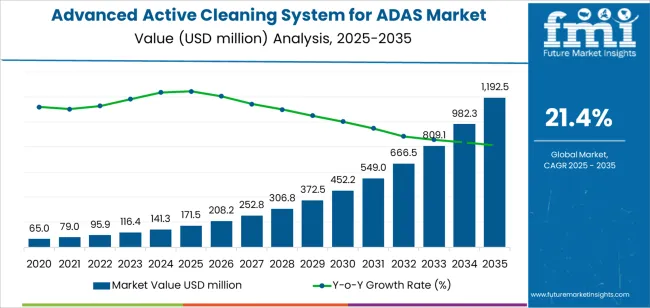
The advanced active cleaning system for ADAS market demonstrates distinct growth phases with varying market characteristics and competitive dynamics. Between 2025 and 2030, the market progresses through its technology adoption phase, expanding from USD 171.5 million to USD 549.1 million with robust annual increments averaging 26.2% growth. This period showcases the transition from basic windshield washer systems to advanced multi-directional cleaning platforms with integrated sensor detection and automated maintenance protocols becoming mainstream features.
The 2025 to 2030 phase adds USD 377.6 million to market value, representing 58% of total decade expansion. Market maturation factors include standardization of cleaning fluid specifications, declining component costs for high-performance actuators, and increasing automotive manufacturer awareness of sensor maintenance benefits reaching 85-90% effectiveness in ADAS performance applications. Competitive landscape evolution during this period features established suppliers like Valeo and Continental AG expanding their cleaning system portfolios while new entrants focus on specialized electric vehicle solutions and autonomous driving compatibility.
From 2030 to 2035, market dynamics shift toward advanced integration and multi-platform deployment, with growth moderating from USD 549.1 million to USD 1,192.7 million, adding USD 643.6 million or 42% of total expansion. This phase transition logic centers on universal cleaning system deployment, integration with predictive maintenance algorithms, and deployment across diverse vehicle architectures, becoming standard rather than optional safety equipment. The competitive environment matures with focus shifting from basic cleaning functionality to comprehensive sensor protection and integration with vehicle intelligence systems.
At-a-Glance Metrics
| Metric | Value |
|---|---|
| Market Value (2025) | USD 171.5 million |
| Market Forecast (2035) | USD 1,192.7 million |
| Growth Rate | 21.4% CAGR |
| Leading Cleaning Type | Liquid Cleaning |
| Primary Application | BEV Segment |
The market demonstrates exceptional fundamentals with liquid cleaning systems capturing a dominant share through superior cleaning effectiveness and cost-efficient integration capabilities. Battery electric vehicle applications drive primary demand, supported by increasing sensor density requirements and enhanced autonomous driving system deployment. Geographic expansion remains concentrated in Asia Pacific markets with established automotive manufacturing infrastructure, while developed economies show accelerating adoption rates driven by regulatory mandates and consumer safety awareness activity.
Market expansion rests on three fundamental shifts driving adoption across automotive and technology sectors. Autonomous vehicle development creates compelling advantages through cleaning system technologies that provide comprehensive sensor protection with automated maintenance compatibility, enabling automotive manufacturers to maintain sensor performance and enhance safety reliability while ensuring consistent ADAS functionality and justifying investment over manual cleaning methods. Electric vehicle adoption accelerates as manufacturers worldwide seek integrated cleaning systems that deliver operational efficiency directly to sensor maintenance operations, enabling performance optimization that aligns with electric powertrain expectations and maximizes sensor reliability throughout vehicle lifecycles. Regulatory compliance increases drive adoption from automotive manufacturers requiring advanced sensor protection that maximizes safety performance while maintaining regulatory standards during testing and operational deployment.
However, growth faces headwinds from integration complexity that differs across vehicle platforms regarding electrical compatibility and control system requirements, potentially limiting standardization consistency in cost-sensitive automotive categories. Technology maturation also persists regarding cleaning effectiveness and sensor compatibility that may increase validation standards in markets with demanding automotive safety protocols.
The advanced active cleaning system for ADAS market represents a compelling intersection of automotive safety innovation, sensor protection technology advancement, and autonomous driving optimization management. With exceptional growth projected from USD 171.5 million in 2025 to USD 1,192.7 million by 2035 at a 21.4% CAGR, this market is driven by increasing autonomous vehicle development trends, electric vehicle adoption requirements, and regulatory demand for reliable sensor maintenance formats.
The market's expansion reflects a fundamental shift in how automotive manufacturers and technology companies approach sensor reliability infrastructure. Strong growth opportunities exist across diverse applications, from battery electric vehicles requiring comprehensive sensor protection to autonomous driving platforms demanding predictive cleaning solutions. Geographic expansion is particularly pronounced in Asia-Pacific markets, led by China (28.9% CAGR) and India (26.8% CAGR), while established markets in Europe and North America drive innovation and specialized segment development.
The dominance of liquid cleaning systems and BEV applications underscores the importance of proven cleaning technology and electrical integration reliability in driving adoption. System complexity and integration challenges remain key barriers, creating opportunities for companies that can deliver consistent performance while maintaining cost efficiency and vehicle compatibility.
Primary Classification: The market segments by cleaning technology into liquid cleaning, gas cleaning, liquid-gas mixed cleaning, and ultrasonic cleaning categories, representing the evolution from basic fluid systems to advanced multi-modal platforms for comprehensive sensor maintenance operations.
Secondary Breakdown: Application segmentation divides the market into battery electric vehicles (BEV), plug-in hybrid electric vehicles (PHEV), internal combustion engine vehicles (ICE), autonomous vehicles, and commercial vehicles, reflecting distinct requirements for power efficiency, integration complexity, and performance specifications.
Tertiary Classification: Sensor type segmentation covers camera lens cleaning, lidar protection, radar maintenance, ultrasonic sensor care, and multi-sensor platforms, addressing specific cleaning requirements across diverse ADAS architectures.
Regional Classification: Geographic distribution covers Asia Pacific, Europe, North America, Latin America, and Middle East & Africa, with Asia Pacific markets leading innovation while established automotive regions show accelerating adoption patterns driven by regulatory requirements and safety initiatives.
The segmentation structure reveals technology progression from standard liquid systems toward integrated multi-modal platforms with enhanced automation and sensor-specific capabilities, while application diversity spans from conventional vehicles to autonomous platforms requiring comprehensive sensor maintenance and performance optimization solutions.
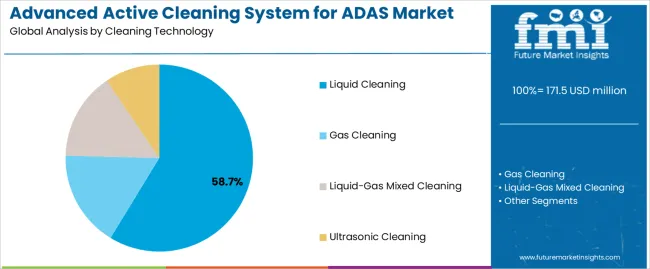
Liquid cleaning segment is estimated to account for 58.7% of the advanced active cleaning system for ADAS market share in 2025. The segment's leading position stems from its fundamental role as a critical component in sensor maintenance applications and its extensive use across multiple vehicle platforms and ADAS architectures. Liquid cleaning's dominance is attributed to its superior cleaning effectiveness, including excellent debris removal, reliable streak-free performance, and balanced cost-effectiveness that make it indispensable for everyday sensor maintenance operations.
Market Position: Liquid cleaning systems command the leading position in the advanced active cleaning system market through proven spray technologies, including comprehensive nozzle design, uniform fluid distribution, and reliable pump performance that enable manufacturers to deploy cleaning solutions across diverse sensor environments.
Value Drivers: The segment benefits from automotive manufacturer preference for established cleaning profiles that provide exceptional reliability without requiring premium system costs. Efficient fluid management enables deployment in camera systems, sensor arrays, and integrated platforms where cleaning consistency and cost efficiency represent critical selection requirements.
Competitive Advantages: Liquid cleaning systems differentiate through excellent contamination removal, proven weather resistance, and compatibility with standard automotive electrical systems that enhance sensor performance while maintaining economical integration profiles suitable for diverse vehicle applications.
Key market characteristics:
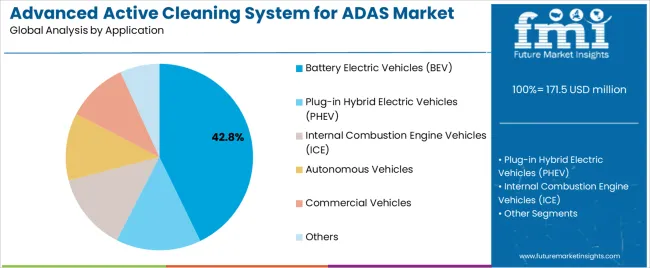
Battery electric vehicle segment is projected to hold 42.8% of the advanced active cleaning system for ADAS market share in 2025. The segment's market leadership is driven by the extensive integration of advanced sensor suites in electric vehicles, autonomous driving capabilities, and comprehensive ADAS deployment, where cleaning systems serve as both performance enablers and safety solutions. The BEV sector's consistent demand for reliable sensor maintenance supports the segment's dominant position.
Market Context: BEV applications dominate the market due to widespread adoption of autonomous driving features and increasing focus on sensor reliability, performance optimization, and safety compliance that enhance vehicle capabilities while maintaining operational standards.
Appeal Factors: Electric vehicle manufacturers prioritize energy efficiency, seamless integration, and compatibility with electric powertrains that enable coordinated deployment across multiple sensor platforms. The segment benefits from substantial electric vehicle adoption and autonomous driving development that emphasize reliable sensor maintenance systems for advanced automotive applications.
Growth Drivers: Autonomous vehicle programs incorporate cleaning systems as standard components for sensor protection and performance maintenance. At the same time, electric vehicle initiatives are increasing demand for energy-efficient features that comply with electrical architecture requirements and enhance system integration.
Market Challenges: Integration complexity and electrical compatibility may limit deployment flexibility in cost-sensitive vehicle segments or platforms with varying power management requirements.
Application dynamics include:
Growth Accelerators: Autonomous vehicle development drives primary adoption as cleaning system technologies provide exceptional sensor protection capabilities that enable ADAS operation without performance degradation, supporting safety improvement and regulatory compliance that require reliable maintenance formats. Electric vehicle adoption accelerates market expansion as manufacturers seek integrated cleaning solutions that maintain sensor performance during operation while enhancing driving assistance through automated maintenance and compatibility. Technology advancement increases worldwide, creating sustained demand for predictive cleaning systems that complement autonomous driving routines and provide operational advantages in sensor reliability and performance optimization.
Growth Inhibitors: Integration complexity challenges differ across vehicle platforms regarding electrical compatibility and control system requirements, which may limit standardization predictability and cost planning in price-sensitive automotive categories with demanding integration requirements. Regulatory validation persists regarding cleaning effectiveness and sensor compatibility that may increase development costs in jurisdictions with strict automotive safety protocols. Market fragmentation across multiple sensor types and cleaning specifications creates compatibility concerns between different ADAS architectures and existing vehicle electrical infrastructure.
Market Evolution Patterns: Adoption accelerates in premium and electric vehicle sectors where performance benefits justify system investments, with geographic concentration in Asia Pacific markets transitioning toward mainstream adoption in established automotive regions driven by regulation and safety development. Technology advancement focuses on enhanced cleaning precision, improved energy efficiency, and integration with vehicle intelligence systems that optimize sensor performance and maintenance consistency. The market could face disruption if alternative sensor protection methods or maintenance technologies significantly challenge traditional cleaning system advantages in ADAS applications.
The advanced active cleaning system for ADAS market demonstrates varied regional dynamics with growth leaders including China (28.9% CAGR) and India (26.8% CAGR) driving expansion through electric vehicle adoption and autonomous driving development. Strong performers encompass Germany (24.6% CAGR), Brazil (22.5% CAGR), and the USA (20.3% CAGR), benefiting from established automotive manufacturing and advanced technology adoption.
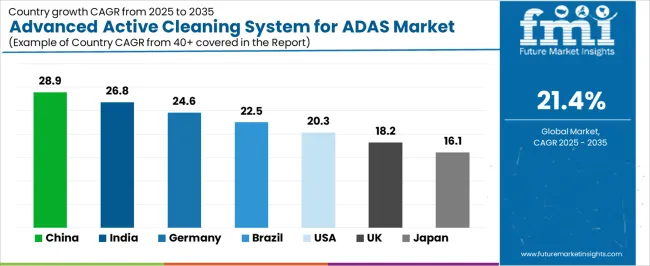
| Country | CAGR (2025 to 2035) |
|---|---|
| China | 28.9% |
| India | 26.8% |
| Germany | 24.6% |
| Brazil | 22.5% |
| USA | 20.3% |
| UK | 18.2% |
| Japan | 16.1% |
Regional synthesis reveals Asia-Pacific markets leading growth through electric vehicle manufacturing expansion and autonomous driving development, while European countries maintain robust expansion supported by automotive innovation and regulatory compliance requirements. North American markets show strong growth driven by technology advancement and premium vehicle adoption.
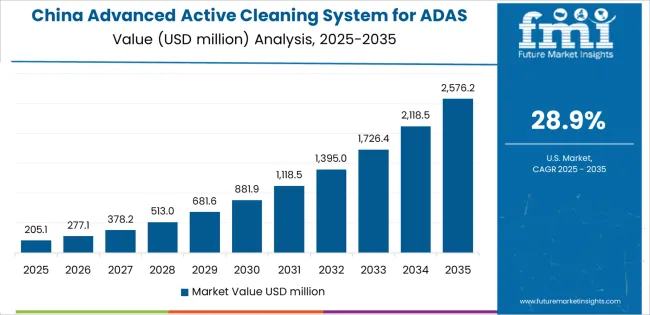
China establishes regional leadership through rapid electric vehicle deployment and comprehensive autonomous driving development, integrating advanced cleaning system technologies as standard components in EV manufacturing and sensor protection operations. The country's 28.9% CAGR through 2035 reflects automotive transformation promoting electric vehicle adoption and autonomous driving infrastructure development that mandate the use of reliable sensor maintenance systems in vehicle operations. Growth concentrates in major automotive centers, including Shanghai, Guangzhou, and Shenzhen, where manufacturing facilities showcase integrated cleaning system platforms that appeal to automotive manufacturers seeking enhanced sensor protection and international automotive safety standards.
Chinese manufacturers are developing innovative cleaning system solutions that combine domestic production advantages with international technology specifications, including multi-sensor platforms and advanced fluid management capabilities.
Strategic Market Indicators:
The Indian market emphasizes automotive modernization applications, including rapid vehicle electrification and comprehensive safety system deployment that increasingly incorporates cleaning systems for sensor protection and ADAS enhancement applications. The country is projected to show a 26.8% CAGR through 2035, driven by automotive manufacturing growth under electric vehicle initiatives and consumer demand for advanced safety features and reliable sensor performance capabilities. Indian automotive facilities prioritize cost-effectiveness with cleaning systems delivering operational efficiency through economical integration and reliable maintenance performance.
Technology deployment channels include major automotive manufacturers, technology suppliers, and vehicle assembly facilities that support high-volume integration for domestic and international applications.
Performance Metrics:
The German market emphasizes advanced cleaning system features, including precision engineering technologies and integration with comprehensive ADAS platforms that manage camera protection, lidar maintenance, and sensor optimization through unified cleaning systems. The country is projected to show a 24.6% CAGR through 2035, driven by automotive innovation under premium vehicle development trends and manufacturer demand for advanced, reliable sensor maintenance systems. German automotive companies prioritize engineering excellence with cleaning systems delivering comprehensive sensor protection through enhanced precision technology and operational innovation.
Technology deployment channels include major automotive manufacturers, tier-1 suppliers, and research facilities that support custom development for premium operations.
Performance Metrics:
In São Paulo, Belo Horizonte, and Curitiba, Brazilian automotive facilities and manufacturing operators are implementing advanced cleaning system technologies to enhance vehicle capabilities and support operational efficiency that aligns with safety protocols and automotive standards. The Brazilian market demonstrates strong growth with a 22.5% CAGR through 2035, driven by automotive development programs and manufacturing investments that emphasize reliable sensor protection systems for domestic and export vehicle applications. Brazilian automotive facilities are prioritizing cleaning systems that provide exceptional performance reliability while maintaining compliance with international safety standards and minimizing integration complexity, particularly important in vehicle assembly and export manufacturing operations.
Market expansion benefits from automotive programs that mandate enhanced sensor protection in vehicle specifications, creating sustained demand across Brazil's automotive manufacturing sectors, where performance consistency and cost efficiency represent critical requirements.
Strategic Market Indicators:
The USA market emphasizes advanced cleaning system integration, including innovative control technologies and seamless compatibility with comprehensive ADAS platforms that manage sensor protection, performance optimization, and autonomous driving through unified maintenance systems. The country is projected to show a 20.3% CAGR through 2035, driven by technology advancement under autonomous vehicle development trends and regulatory demand for premium, reliable sensor maintenance systems. American automotive companies prioritize innovation with cleaning systems delivering comprehensive sensor protection through advanced automation technology and system integration excellence.
Technology deployment channels include major automotive manufacturers, technology companies, and autonomous vehicle developers that support custom development for advanced operations.
Performance Metrics:
The UK market demonstrates sophisticated cleaning system deployment, growing at 18.2% CAGR, with documented operational excellence in premium vehicle applications and automotive technology integration through compatibility with existing ADAS platforms and quality assurance infrastructure. The country leverages engineering expertise in automotive technology and sensor systems to maintain market competitiveness. Automotive centers, including Coventry, Birmingham, and Oxford, showcase advanced installations where cleaning system technologies integrate with comprehensive vehicle platforms and safety systems to optimize sensor maintenance and operational reliability.
British automotive facilities prioritize integration precision and technology consistency in system selection, creating demand for premium cleaning systems with advanced features, including predictive maintenance and integration with vehicle intelligence protocols. The market benefits from established automotive infrastructure and willingness to invest in specialized sensor technologies that provide superior performance capabilities and regulatory compliance.
Market Intelligence Brief:
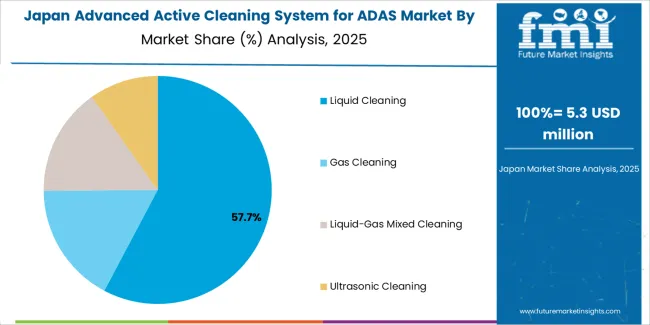
Japan's sophisticated automotive market demonstrates meticulous cleaning system deployment, growing at 16.1% CAGR, with documented operational excellence in sensor protection and automotive integration through integration with existing vehicle systems and precision manufacturing infrastructure. The country leverages engineering expertise in automotive electronics and sensor manufacturing to maintain technology leadership. Manufacturing centers, including Tokyo, Nagoya, and Hiroshima, showcase advanced installations where cleaning systems integrate with comprehensive vehicle platforms and quality control systems to optimize sensor performance and operational efficiency.
Japanese automotive facilities prioritize manufacturing precision and component consistency in product selection, creating demand for premium cleaning systems with advanced features, including ultra-precise actuators and integration with vehicle control protocols. The market benefits from established automotive infrastructure and willingness to invest in specialized sensor technologies that provide superior reliability characteristics and manufacturing excellence.
Market Intelligence Brief:
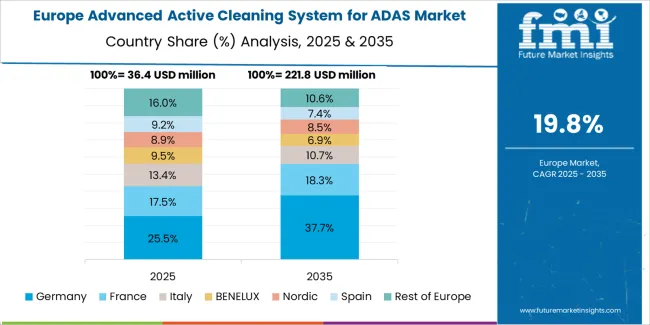
The advanced active cleaning system for ADAS market in Europe is projected to grow from USD 39.8 million in 2025 to USD 287.6 million by 2035, registering a CAGR of 22.1% over the forecast period. Germany is expected to maintain its leadership position with a 38.4% market share in 2025, declining slightly to 37.8% by 2035, supported by its automotive engineering excellence and major manufacturing centers, including Baden-Württemberg and Bavaria.
France follows with a 26.2% share in 2025, projected to reach 26.7% by 2035, driven by comprehensive automotive development programs and electric vehicle manufacturing initiatives. The United Kingdom holds a 18.5% share in 2025, expected to maintain 18.9% by 2035 through established automotive sectors and premium vehicle adoption. Italy commands a 11.3% share, while Spain accounts for 4.8% in 2025. The Rest of Europe region is anticipated to gain momentum, expanding its collective share from 0.8% to 1.3% by 2035, attributed to increasing automotive development in Eastern European countries and emerging electric vehicle manufacturing programs implementing advanced sensor protection systems.
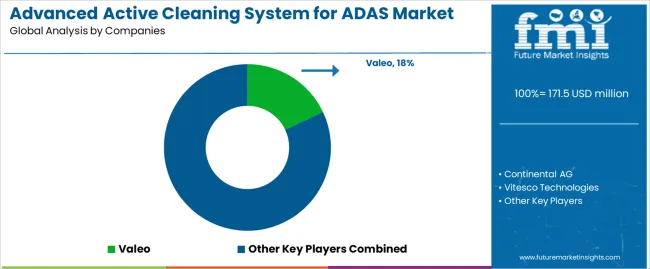
The advanced active cleaning system for ADAS market operates with moderate concentration, featuring approximately 15 to 20 participants, where leading companies control roughly 55-62% of the global market share through established automotive partnerships and comprehensive technology integration capabilities. Competition emphasizes cleaning effectiveness, system reliability, and automotive compatibility rather than premium feature rivalry.
Market leaders encompass Valeo, Continental AG, and Vitesco Technologies, which maintain competitive advantages through extensive automotive manufacturing expertise, global supplier networks, and comprehensive technical integration capabilities that create OEM loyalty and support vehicle manufacturer requirements. These companies leverage decades of automotive component experience and ongoing sensor technology investments to develop advanced cleaning systems with exceptional performance and integration features.
Specialty challengers include Röchling SE & Co. KG, Araymond, and Kautex, which compete through specialized application innovation focus and efficient manufacturing solutions that appeal to automotive buyers seeking reliable performance formats and custom integration flexibility. These companies differentiate through operational efficiency emphasis and specialized automotive market focus.
Market dynamics favor participants that combine consistent cleaning performance with advanced automotive integration support, including electrical compatibility and manufacturing scalability capabilities. Competitive pressure intensifies as traditional automotive suppliers expand into sensor cleaning systems. At the same time, specialized technology companies challenge established players through innovative cleaning methodologies and cost-effective integration targeting emerging electric vehicle segments.
| Item | Value |
|---|---|
| Quantitative Units | USD 171.5 million |
| Cleaning Technology | Liquid Cleaning, Gas Cleaning, Liquid-Gas Mixed Cleaning, Ultrasonic Cleaning |
| Application | BEV, PHEV, ICE Vehicles, Autonomous Vehicles, Commercial Vehicles, Others |
| Sensor Type | Camera Lens Cleaning, Lidar Protection, Radar Maintenance, Ultrasonic Sensor Care, Multi-Sensor Platforms |
| Regions Covered | Asia Pacific, Europe, North America, Latin America, Middle East & Africa |
| Countries Covered | China, India, Germany, Brazil, USA, UK, Japan, and 25+ additional countries |
| Key Companies Profiled | Valeo , Continental AG, Vitesco Technologies, Röchling SE & Co. KG, Araymond , Kautex |
| Additional Attributes | Dollar sales by cleaning technology and application categories, regional adoption trends across Asia Pacific, Europe, and North America, competitive landscape with automotive suppliers and technology companies, vehicle manufacturer preferences for integration compatibility and performance reliability, compatibility with sensor protection equipment and ADAS systems, innovations in cleaning fluid technology and automated systems, and development of specialized sensor maintenance solutions with enhanced cleaning effectiveness and predictive maintenance features |
The global advanced active cleaning system for ADAS market is estimated to be valued at USD 171.5 million in 2025.
The market size for the advanced active cleaning system for ADAS market is projected to reach USD 1,192.5 million by 2035.
The advanced active cleaning system for ADAS market is expected to grow at a 21.4% CAGR between 2025 and 2035.
The key product types in advanced active cleaning system for ADAS market are liquid cleaning, gas cleaning, liquid-gas mixed cleaning and ultrasonic cleaning.
In terms of application, battery electric vehicles (bev) segment to command 42.8% share in the advanced active cleaning system for ADAS market in 2025.






Full Research Suite comprises of:
Market outlook & trends analysis
Interviews & case studies
Strategic recommendations
Vendor profiles & capabilities analysis
5-year forecasts
8 regions and 60+ country-level data splits
Market segment data splits
12 months of continuous data updates
DELIVERED AS:
PDF EXCEL ONLINE
Advanced Lead Acid Battery Market Size and Share Forecast Outlook 2025 to 2035
Advanced Therapeutics Pharmaceutical Outsourcing Market Size and Share Forecast Outlook 2025 to 2035
Advanced Airport Technologies Market Size and Share Forecast Outlook 2025 to 2035
Advanced Air Mobility Market Size and Share Forecast Outlook 2025 to 2035
Advanced Sensor Market Size and Share Forecast Outlook 2025 to 2035
Advanced Combat Helmet Market Size and Share Forecast Outlook 2025 to 2035
Advanced Optics Material Market Size and Share Forecast Outlook 2025 to 2035
Advanced Functional Materials Market Size and Share Forecast Outlook 2025 to 2035
Advanced Drill Data Management Solutions Market Size and Share Forecast Outlook 2025 to 2035
Advanced Water Management And Filtration Equipment Market Size and Share Forecast Outlook 2025 to 2035
Advanced Coating Market Size and Share Forecast Outlook 2025 to 2035
Advanced Aerospace Coatings Industry Analysis in Europe - Size, Share, and Forecast 2025 to 2035
Advanced Tires Market Size and Share Forecast Outlook 2025 to 2035
Advanced Therapy Medicinal Products Market Size and Share Forecast Outlook 2025 to 2035
Advanced Glass Market Size and Share Forecast Outlook 2025 to 2035
Advanced Server Energy Monitoring Tools Market Size and Share Forecast Outlook 2025 to 2035
Advanced Sports Materials Market Size and Share Forecast Outlook 2025 to 2035
Advanced Wound Management Market Growth - Industry Outlook 2025 to 2035
Advanced Packaging Market Size & Share Forecast 2025 to 2035
Advanced Polymer Composites Market Growth - Trends & Forecast 2025 to 2035

Thank you!
You will receive an email from our Business Development Manager. Please be sure to check your SPAM/JUNK folder too.
Chat With
MaRIA